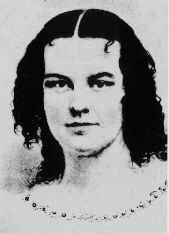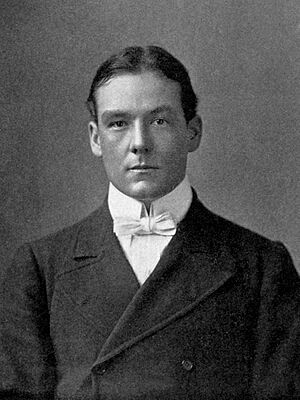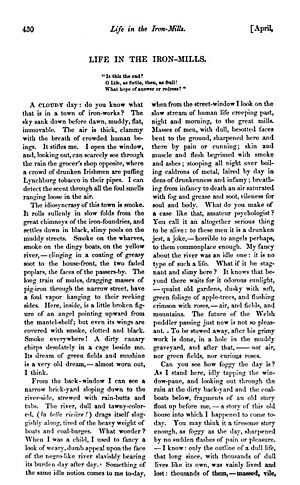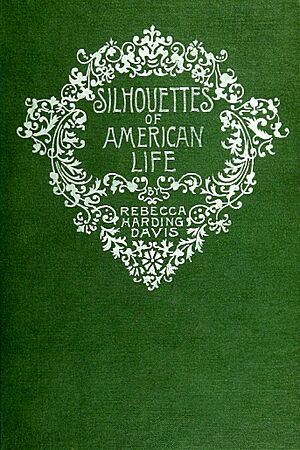Rebecca Harding Davis facts for kids
Quick facts for kids
Rebecca Harding Davis
|
|
|---|---|
 |
|
| Born | Rebecca Blaine Harding June 24, 1831 Washington, Pennsylvania |
| Died | September 29, 1910 (aged 79) Mount Kisco, New York |
| Genre | Fiction, journalism, poetry |
| Notable works | Life in the Iron Mills |
| Signature | |
Rebecca Blaine Harding Davis (born June 24, 1831 – died September 29, 1910) was an American writer and journalist. She was a very important early writer of literary realism in American literature. This means she wrote about life as it really was, not just in a romantic or idealized way.
Rebecca graduated at the top of her class from Washington Female Seminary in Pennsylvania. Her most famous work is the short story "Life in the Iron-Mills." It was published in April 1861 in a magazine called The Atlantic Monthly. Throughout her life, Rebecca wanted to make society better. She wrote about the struggles of African Americans, women, Native Americans, immigrants, and working-class people in the 1800s. She wanted to show their challenges and help bring about change.
Contents
Rebecca's Early Life
Rebecca Blaine Harding was born on June 24, 1831, in Washington, Pennsylvania. Her parents were Richard and Rachel Leet Wilson Harding. Rebecca was the oldest of five children. Her family moved around a bit before settling in 1836 in Wheeling. At that time, Wheeling was part of Virginia.
Wheeling was growing into a busy factory town, especially known for its iron and steel mills. The world around Rebecca in her hometown later influenced her stories, like "Life in the Iron-Mills." Even though Wheeling was busy, Rebecca remembered her childhood as a simpler time. She wrote in her 1904 autobiography Bits of Gossip that there were "no railways," "no automobiles," and "no sky-scraping houses" back then.
Rebecca's Education
When Rebecca was a young child, there were no public schools in her hometown. So, her mother taught her at home, and she also had some tutors. While learning at home, Rebecca read books by authors like Harriet Beecher Stowe. These books made her interested in writing and literature.
When Rebecca was fourteen, she went to live with her aunt in Washington, Pennsylvania. She attended the Washington Female Seminary there. She finished school in 1848, at age seventeen, as the best student in her class. Rebecca said the school taught "enough math to do accounts," "a little music and drawing," and lots of "French, history, literature." After returning to Wheeling, she started working for the local newspaper, the Intelligencer. She wrote reviews, stories, poems, and even edited for a short time in 1859.
Rebecca's Family Life
After Rebecca returned to Wheeling, she mostly stayed with her family. She lived a quiet life for thirteen years until her famous story Life in the Iron Mills was published in 1861.
Life in the Iron Mills came out in The Atlantic Monthly magazine in April 1861. Many experts believe this story was a big step for realism in American writing. When it was published, other famous writers like Louisa May Alcott and Ralph Waldo Emerson praised Rebecca as a "brave new voice." They liked that she wanted "to dig into the commonplace, this vulgar American life, and see what is in it." Rebecca later met Emerson and Nathaniel Hawthorne during a trip to meet her publisher, James T. Fields. She really admired these American writers.
On her way back from meeting her publisher, Rebecca met L. Clarke Davis in Philadelphia. They had been writing letters to each other because he admired her work after "Life in the Iron-Mills" came out. They got engaged just one week after meeting and were married on March 5, 1863. Clarke was four years younger than Rebecca and was still starting his career.
The next year, Rebecca gave birth to their first son, Richard Harding Davis. He also grew up to be a writer and journalist. Their second son, Charles Belmont Davis, was born in 1866 and also became a writer. Their daughter, Nora, was born in 1872.
At the beginning of their marriage, Rebecca was the main person earning money for the family through her writing. She also worked as an editor for the New York Tribune. About ten years after they married, Rebecca wrote less. Clarke became an editor for The Philadelphia Inquirer. In 1892, Rebecca had a small success with her book Silhouettes of American Life. She passed away at age 79 on September 29, 1910.
Rebecca's Lasting Impact
Rebecca Harding Davis wrote over 500 published works! But sadly, she was almost completely forgotten by the time she died in 1910. However, she was "rediscovered" in the early 1970s by a feminist writer named Tillie Olsen. Olsen found some of Rebecca's old books in a junk shop. She quickly realized how talented and important Rebecca's writing was.
Tillie Olsen worked hard to bring Rebecca's work back to public attention. In 1972, a publisher called The Feminist Press republished "Life in the Iron-Mills." It included Olsen's own thoughts on Rebecca's life and writings. Olsen's book, Silences, also studied why some authors stop writing or don't get published, especially working-class writers and women. The second part of her book focused on Rebecca's work.
In April 2013, a historical marker was placed in Rebecca's honor near Swanson Science Center in Washington, Pennsylvania. This was where the Washington Female Seminary used to be. This marker was the first one dedicated to a woman in Washington, Pennsylvania.
"Life in the Iron-Mills": A Key Work
"Life in the Iron-Mills"; or, The Korl Woman is thought to be Rebecca Harding Davis's most important work. It was published in 1861 and was one of the first stories to explore the effects of factories and industry in American literature. It came out around the start of the American Civil War.
This short story is important not just for its artistic quality but also for its historical meaning. Both its style and what it was about were new at the time. It told the story of factory workers' lives and the results of industrialization in a very realistic way.
"Life in the Iron-Mills" takes place in a small village centered around factory work, especially iron mills. The village is described as polluted and sad, filled with laborers. The main character is Hugh Wolfe, an iron mill worker. He has artistic talent and wants more from life. But despite his hopes, he becomes a tragic hero. His wish for a better life leads to him being put in prison and eventually dying.
Even though the story deals with big ideas like industrialization and the working class, Rebecca's writing makes you focus on Hugh Wolfe as an individual. She shows how the harsh realities of factory life affect his heart and soul. In the story, Rebecca shows what happened to workers and suggests that they needed moral education and social help.
Rebecca's Writing Style
Rebecca Harding Davis's writing style is usually called realism. This means she tried to show life exactly as it was. However, her works also show a change from romanticism to realism. So, they mix parts of different styles like Sentimentalism, Romanticism, Realism, and Naturalism.
For example, "Life in the Iron-Mills" uses sentimental elements. The narrator talks directly to the reader, trying to make them feel strong emotions and encourage them to act. The story also has Romantic elements, like a statue that represents a woman who longs for more in life. It also uses a realistic style, with detailed descriptions like a journalist would write. The characters speak like real people from their social class.
While realism is the main style for Rebecca's work, naturalism is also often seen. Naturalism is linked to realism. Realists, like Rebecca, try to show reality. Naturalists go further by looking at how a character's surroundings affect them scientifically or psychologically. In Life in the Iron Mills, these two styles are mixed. This creates a realistic picture of Hugh Wolfe's daily life as an iron mill worker. It also shows how that environment affects him.
Besides realism and naturalism, Rebecca also wrote in other styles, like gothic (stories with mystery and horror) and folklore (traditional stories).
Main Themes in Rebecca's Work
Rebecca Harding Davis often wrote about important social and political issues of the 1800s. These included the American Civil War, race, different regions of the country, the working class, and women's roles.
Industrialism
Rebecca lived in the steel town of Wheeling, West Virginia. So, she saw firsthand the problems and difficulties that came with industrialism. She uses the theme of industrialism in Life in the Iron Mills by showing the dark and gloomy setting of the iron mills. She describes not only the sad landscape but also the working-class people.
By exploring how the iron mills affected the people who lived there, Rebecca showed her own worries and frustrations about how working-class people were treated. Her descriptions of the daily lives of laborers are common in her writing. Her main goal was to show how these people were mistreated. She wanted her readers to think about spiritual solutions to these problems, not just social ones.
Women's Roles in Society
Rebecca's works often explore the roles women played in 19th-century society. Her female characters can be seen as early examples of proto-feminism. They show the problems women faced, like being seen as property, and how society limited their identity.
These issues appear in her novel Margret Howth. Even though Margret works in the mills, her problems come from her relationships with men. By the end of the novel, she marries Stephen Holmes. This can show her accepting her role as a wife and mother. Through this character, Rebecca shows the power that society had over women in the 1800s. But she also presents a strong female character who knows she has her own moral independence. Rebecca also looked at how important domestic life (home life) was for her characters. She changed the idea of domesticity by placing women in the iron mills. By describing the tough conditions these women worked in, Rebecca showed that women could handle both work life and home life.
Another work where Rebecca shows the power of a female figure is Life in the Iron Mills. The Korl Woman, a sculpture made by Hugh Wolfe, is a powerful image of working-class womanhood. The strong feelings this figure creates, and its human-like qualities, send a message. They reveal the true image of not only laborers but also female beauty. The Korl Woman challenges the ideas of what was considered feminine in the 1800s. So, Rebecca uses the Korl Woman to show the real effects of the iron mills. At the same time, she questions society's limits on women.
Rebecca's Works (Some Examples)
Books
- Margret Howth: A Story of Today (1861)
- Waiting for the Verdict (1867)
- Dallas Galbraith (1868)
- Kitty's Choice or Berrytown and Other Stories (1873)
- John Andross (1874)
- A Law unto Herself (1878)
- Natasqua (1886)
- Kent Hampden (1892)
- Silhouettes of American Life (1892)
- Doctor Warrick's Daughters (1896)
- Frances Waldeaux (1897)
- Bits of Gossip (1904)
Short Stories
- Life in the Iron Mills, The Atlantic Monthly (1861)
- David Gaunt (1862)
- John Lamar (1862)
- Paul Blecker (1863)
- The Wife's Story (July 1864), The Atlantic Monthly
- Ellen (1865)
- The Harmonists (1866)
- In the Market (1868)
- A Pearl of Great Price (1868)
- Put out of the Way (1870)
- The Balacchi Brothers (1872) Lippincott's Magazine
- General William Wirt Colby, Wood's Household Magazine (1873)
- Earthen Pitchers (1873–1874)
- Marcia (1876)
- A Day with Doctor Sarah (1878)
Essays
- Men's Rights (1869)
- The House on the Beach (1876)
- Life Saving Stations (March 1876) Lippincott's Magazine
- Some Testimony in the Case (1885)
- Here and There in the South (1887)
- Women in Literature (1891)
- In the Gray Cabins of New England (1895)
- The Disease of Money-Getting (1902)





